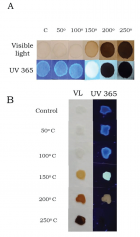Abstract
Research Article
Environmental influence on blood serum detection using ultraviolet 365
Kelly P Kearse*
Published: 26 March, 2021 | Volume 5 - Issue 1 | Pages: 030-036
The major use of alternative light sources (ALS) in the evaluation of bloodstains has been primarily focused on detection of whole blood, with relatively little attention to visualization of blood serum. Serum may become separated from blood pools during clotting, and because it is relatively invisible on certain backgrounds, go undetected by a perpetrator attempting to clean up a crime scene. Recently, Ultraviolet 365 (UV 365) was shown to be an effective tool in blood evaluation, useful for detection of even minute quantities of blood serum. Here the effects of environmental conditions on blood serum stain appearance were evaluated, including temperature, pH, protease sensitivity, solubility, and aging. Interestingly, it was found that the UV fluorescence of serum increases upon exposure to heat, which was accompanied by color changes under visible light and decreased solubility in multiple solvents. The efficiency of visualization of serum stains was somewhat variable, depending on the type of material on which it was dried. Finally, the current study documents the effect of heating on formation of fluorescent serum halo rings in dried bloodstains. Taken together, these data demonstrate that blood serum detection may be affected by certain conditions that influence its visualization under both visible and UV light.
Read Full Article HTML DOI: 10.29328/journal.jfsr.1001024 Cite this Article Read Full Article PDF
Keywords:
Boodstains; Serum; UV365, Bood serum stain
References
- Kearse KP. Ultraviolet 365 as an Alternative Light Source for Detection of Blood Serum. J Forensic Sci. 2020; 65: 1716-1721. PubMed: https://pubmed.ncbi.nlm.nih.gov/32343369/
- Saito M, Taira H. Heat Denaturation and Emulsifying Properties of Plasma Protein. Agric Biol Chem. 1987; 51: 2787-2792.
- Brady T, Tigmo J, Graham G. Extreme Temperature Effects on Bloodstain Pattern Analysis. I.A.B.P.A Newsletter. 2002; 3-20.
- Borzova VA, Markossian KA, Chebotareva NA, Kleymenov SY, Poliansky NB, et al. Kinetics of Thermal Degradation and Aggregation of Bovine Serum Albumin. PloS One. 2106; 11: e0153495. PubMed: https://pubmed.ncbi.nlm.nih.gov/27101281/
- Larkin BAJ, Banks CE. Preliminary Study on the Effect of Heated Surfaces Upon Bloodstain Pattern Analysis. J Forensic Sci. 2013; 58: 1289-1296. PubMed: https://pubmed.ncbi.nlm.nih.gov/23865610/
- Tontarski KL, Hoskins KA, Watkins TG, Brun-Conti L, Michaud AL. Chemical Enhancement Techniques of Bloodstain Patterns and DNA Recovery after Fire Exposure. J. Forensic Sci. 2009; 54: 37-48. PubMed: https://pubmed.ncbi.nlm.nih.gov/19018938/
Figures:

Figure 1

Figure 2

Figure 3

Figure 4

Figure 5

Figure 6

Figure 7

Figure 8

Figure 9

Figure 10
Similar Articles
-
Environmental influence on blood serum detection using ultraviolet 365Kelly P Kearse*. Environmental influence on blood serum detection using ultraviolet 365. . 2021 doi: 10.29328/journal.jfsr.1001024; 5: 030-036
-
Ultraviolet fluorescent detection of elevated bilirubin in dried blood serumKelly P Kearse*. Ultraviolet fluorescent detection of elevated bilirubin in dried blood serum. . 2022 doi: 10.29328/journal.jfsr.1001036; 6: 049-052
-
The Effect of Humidity on Blood Serum Pattern Formation and Blood TransferKelly P Kearse*. The Effect of Humidity on Blood Serum Pattern Formation and Blood Transfer. . 2023 doi: 10.29328/journal.jfsr.1001048; 7: 040-048.
Recently Viewed
-
Metastatic Brain Melanoma: A Rare Case with Review of LiteratureNeha Singh,Gaurav Raj,Akshay Kumar,Deepak Kumar Singh,Shivansh Dixit,Kaustubh Gupta*. Metastatic Brain Melanoma: A Rare Case with Review of Literature. J Radiol Oncol. 2025: doi: 10.29328/journal.jro.1001080; 9: 050-053
-
Validation of Prognostic Scores for Attempted Vaginal Delivery in Scar UterusMouiman Soukaina*,Mourran Oumaima,Etber Amina,Zeraidi Najia,Slaoui Aziz,Baydada Aziz. Validation of Prognostic Scores for Attempted Vaginal Delivery in Scar Uterus. Clin J Obstet Gynecol. 2025: doi: 10.29328/journal.cjog.1001185; 8: 023-029
-
Scientific Analysis of Eucharistic Miracles: Importance of a Standardization in EvaluationKelly Kearse*,Frank Ligaj. Scientific Analysis of Eucharistic Miracles: Importance of a Standardization in Evaluation. J Forensic Sci Res. 2024: doi: 10.29328/journal.jfsr.1001068; 8: 078-088
-
A study of coagulation profile in patients with cancer in a tertiary care hospitalGaurav Khichariya,Manjula K*,Subhashish Das,Kalyani R. A study of coagulation profile in patients with cancer in a tertiary care hospital. J Hematol Clin Res. 2021: doi: 10.29328/journal.jhcr.1001015; 5: 001-003
-
Additional Gold Recovery from Tailing Waste By Ion Exchange ResinsAshrapov UT*, Malikov Sh R, Erdanov MN, Mirzaev BB. Additional Gold Recovery from Tailing Waste By Ion Exchange Resins. Int J Phys Res Appl. 2024: doi: 10.29328/journal.ijpra.1001098; 7: 132-138
Most Viewed
-
Evaluation of Biostimulants Based on Recovered Protein Hydrolysates from Animal By-products as Plant Growth EnhancersH Pérez-Aguilar*, M Lacruz-Asaro, F Arán-Ais. Evaluation of Biostimulants Based on Recovered Protein Hydrolysates from Animal By-products as Plant Growth Enhancers. J Plant Sci Phytopathol. 2023 doi: 10.29328/journal.jpsp.1001104; 7: 042-047
-
Sinonasal Myxoma Extending into the Orbit in a 4-Year Old: A Case PresentationJulian A Purrinos*, Ramzi Younis. Sinonasal Myxoma Extending into the Orbit in a 4-Year Old: A Case Presentation. Arch Case Rep. 2024 doi: 10.29328/journal.acr.1001099; 8: 075-077
-
Feasibility study of magnetic sensing for detecting single-neuron action potentialsDenis Tonini,Kai Wu,Renata Saha,Jian-Ping Wang*. Feasibility study of magnetic sensing for detecting single-neuron action potentials. Ann Biomed Sci Eng. 2022 doi: 10.29328/journal.abse.1001018; 6: 019-029
-
Pediatric Dysgerminoma: Unveiling a Rare Ovarian TumorFaten Limaiem*, Khalil Saffar, Ahmed Halouani. Pediatric Dysgerminoma: Unveiling a Rare Ovarian Tumor. Arch Case Rep. 2024 doi: 10.29328/journal.acr.1001087; 8: 010-013
-
Physical activity can change the physiological and psychological circumstances during COVID-19 pandemic: A narrative reviewKhashayar Maroufi*. Physical activity can change the physiological and psychological circumstances during COVID-19 pandemic: A narrative review. J Sports Med Ther. 2021 doi: 10.29328/journal.jsmt.1001051; 6: 001-007

HSPI: We're glad you're here. Please click "create a new Query" if you are a new visitor to our website and need further information from us.
If you are already a member of our network and need to keep track of any developments regarding a question you have already submitted, click "take me to my Query."













































































































































